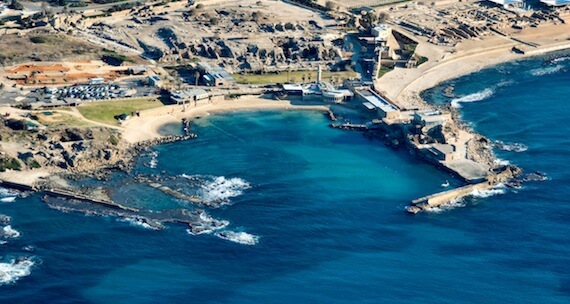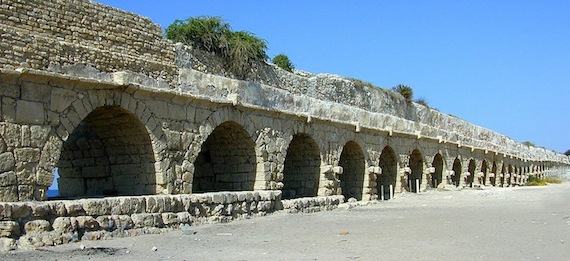The straight line of Israel’s seacoast has never lent itself to significant harbors. For centuries, only Joppa in the south and Acco in the north provided modest havens for ships. But in 22 BC, work began on a new port—a vast harbor befitting the grand ideals of its visionary, King Herod the Great.

(Photo: Caesarea’s Ancient Harbor, courtesy of Pictorial Library of Bible Lands)
At Caesarea today, a modern harbor rests in the same location as the ancient one. The few fishing vessels and pleasure boats moored to the modern pier do little justice to the port of the first century.
I shot the following video while flying in a helicopter over Caesarea.
Above Caesarea
In this video, you’ll see the ancient theater, Herod’s palace promontory, the hippodrome, and the ancient harbor.
(Video courtesy of Insight for Living)
Israel’s Manmade Harbor
Herod named the city, “Caesarea,” in honor of Caesar Augustus.
To further ingratiate the Roman ruler, Herod raised a temple for Augustus on the hill above the harbor. You can still see the ruins of the temple today. The site of the ancient harbor is today largely silted and covered with St. Augustine grass.
[slideshow id=30]
(All pics courtesy of the Pictorial Library of Bible Lands)
Herod’s harbor dwarfed the docks of today.
- Built on a grand scale, the ancient harbor extended out into the sea through an ingenious use of concrete that hardened under the water.
- In its heyday, the enclosed harbor covered over forty acres and could accommodate three hundred vessels.
- It’s no wonder the site became one of the most significant seaports of the eastern Mediterranean.
The Aqueduct—They Don’t Build Them Like They Used To
To provide Caesarea with sufficient fresh water, Herod built an aqueduct that stretched ten miles north to the springs below Mount Carmel.
- As history unfolded, the Roman Emperor Hadrian and the Crusaders would build additional channels on top of Herod’s aqueduct.
- A portion of this marvelous structure still stands for visitors to enjoy.
- Just standing beneath its arches causes one to marvel at the time, skill, and ingenuity of those who constructed it over two thousand years ago.
The aqueduct also speaks of the importance of water in the Land of Israel.

(Photo: Caesarea’s Roman aqueduct, courtesy of Pictorial Library of Bible Lands)
Herod’s Palace, Where Pilate Lived and Paul was Imprisoned
Herod chose to build his lavish palace in Caesarea on a natural promontory that juts out into the Mediterranean Sea.
- The king had a freshwater swimming pool carved out of the natural bedrock at the end of his palace; the sprawling pool was almost Olympic in size.
- Standing on this promontory today allows visitors to see where Herod’s pool once was and to imagine the luxury of Herod’s palace, which the Jewish historian Josephus called, “the most magnificent.”
After the death of Herod the Great in 4 BC, Caesarea became the Roman seat of power in Israel for 500 years. Roman governors, or procurators, resided in Herod’s opulent palace in Caesarea.
The Apostle Paul was imprisoned on the grounds of the palace (or “Praetorium”) for two full years (Acts 23:35; 24:27). A sign today marks the likely spot.
The Pontius Pilate Inscription
When an team of Italian archaeologists excavated in Caesarea in 1961, they discovered an inscription with the words translated, “Pontius Pilate, Prefect of Judea.”
- This archaeological find is the only written source outside of the New Testament that mentions the name, “Pontius Pilate”—the procurator who lived in Caesarea and who condemned Jesus of Nazareth to death.
- A replica of the inscription stands in Caesarea today, and the original stands on display in the Israel Museum in Jerusalem.
In the Google Street view window below, the Pontius Pilate inscription stands in the foreground and Herod’s Palace is in the background. Use the buttons to explore and look around!
Caesarea National Park enjoys about 1 million visitors annually—and for good reason.
- A state-of-the-art visitors center offers a historical perspective, complete with hologram tour guides such as King Herod, Rabbi Akiva, the Apostle Paul, and Saladin, just to name a few.
- The video called, “The Caesarea Experience,” traces Caesarea’s history on all periods of time—a great introduction to the site.
Next week we’ll explore more of Caesarea’s treasures—namely, its ancient entertainment.
Tell me what you think: What most fascinates you about Caesarea? To leave a comment, just click here.
Caesarea on the Map:
See Caesarea & More In Person
Journey to the Bible Lands with Wayne Stiles. You will NEVER be the same! Learn more:

